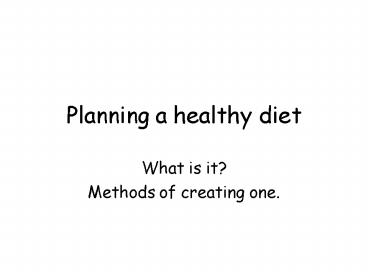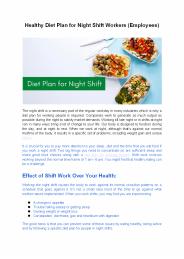Planning a healthy diet - PowerPoint PPT Presentation
1 / 46
Title:
Planning a healthy diet
Description:
MyPyramid (Food Guide Pyramid) Diet plans. Ask your Grandma. Food Labels: History ... Food Pyramid & MyPyramid ... count as added fat at the tip of the Pyramid. ... – PowerPoint PPT presentation
Number of Views:128
Avg rating:3.0/5.0
Title: Planning a healthy diet
1
Planning a healthy diet
- What is it?
- Methods of creating one.
2
(No Transcript)
3
What is a diet?
- An eating plan that restricts food intake?
- A plan that reduces calorie intake?
- A plan that eliminates fatty foods?
- A plan that eliminates tasty foods?
- One that eliminates junk food?
4
How is America doing?
- In 2001, of school-age children consuming a
diet that meets national regs. 2! (Hueter,
2002) - As of 1998
- 13 of children are overweight
- 61 of adults are overweight
5
Contributors to excess death
- The second highest contributor to excess death is
diet four of the top five causes of death are
diet related
1999-2003
6
Are American diets healthful?
7
Requirements of ahealthful diet
- Adequate - enough to support health
- energy, nutrients, fiber, etc.
- Moderate - Go easy on foods high in fat added
sugar - Balanced - right proportions of nutrients
- Varied - Diversity ensures intake of all
micronutrients - Nutrient Dense foods - high nutrient, low energy
(kcal)
8
Energy Density of Two Breakfast Options Compared
LOWER ENERGY DENSITY
HIGHER ENERGY DENSITY
This 450-gram breakfast delivers 500 kcalories,
for an energy density of 1.1 (500 kcal 450 g
1.1 kcal/g).
This 144-gram breakfast also delivers 500
kcalories, for an energy density of 3.5 (500 kcal
144 g 3.5 kcal/g).
9
How do I design a diet?
- Tools may include
- Food labels
- Dietary guidelines
- MyPyramid (Food Guide Pyramid)
- Diet plans
- Ask your Grandma
10
Food Labels History
- Prior to 1973, NO requirement to include
nutrition information on labels - 1990 - Congress passes National Labeling and
Education Act requires nutrition information for
most foods
11
Food Label Contents
- FDA requires food labels on most products. Labels
must include - Statement of identity
- Net contents of the package (wt, vol, )
- Ingredients list (in descending order by wt.)
- Manufacturers name and address
- Nutrition information (Nutrition Facts Panel)
- most useful parts
12
Food Label Nutrition Facts Panel
The serving size and number of servings per
container
kCalorie information and quantities of nutrients
per serving, in actual amounts
The name and address of the manufacturer, packer,
or distributor
The common or usual product name
Quantities of nutrients as Daily Values
based on a 2000-kcalorie energy intake
Approved nutrient claims if the product meets
specified criteria
The net contents in weight, measure, or count
Daily Values reminder for selected nutrients for
a 2000- and a 2500- kcalorie diet
Approved health claims stated in terms of the
total diet
kCalorie per gram reminder
The ingredients in descending order
of predominance by weight
13
Nutrition Facts Panel
- Serving size servings per container
- Calories and calories from fat per serving
- List of nutrients (top nutrients we try to
limit bottom those we want lots of) - Percent daily values (DV, based on 2000 kcal
diet). - Footnote
14
Nutrition Facts Panel
- Serving size servings per container
- Serving size is probably less than you think
- Standardization allows easy comparison among
similar products
- According to MyPyramid
- 1/2 of a 2-oz. bagel 1 serving.
- Most bagels these days are 4 oz.s!
15
Nutrition Facts Panel
- Calories and calories from fat per serving
- (ET EF/ET)
- Use it to determine if a food is relatively high
or low in fat - ET 250
- EF 50
- EF/ET 20
16
Nutrition Facts Panel
- List of nutrients
- Fat (Total and saturated)
- Cholesterol
- Sodium Potassium
- Carbohydrates
- Protein
- Vitamins and minerals (A, C, Calcium, Iron)
17
Nutrition Facts Panel
- Percent Daily Values (DV)
- Based on
- A diet of 2,000 cal/day
- Reference Daily Intakes (RDI) for foods with RDA
value - Daily Reference Values (DRV) for foods without
RDA value - What good is this?
18
Table 2-6Page 58
19
Nutrition Facts Panel
- Footnote
- Contains general dietary advice for all people
- Must be present on all food labels
- Compares a 2,000 calorie diet with a 2,500
calorie diet
20
Dietary Guidelines
- Dietary Guidelines for Americans
- General advice for nutrition and health from
- US Department of Health and Human Services
- US Department of Agriculture
- Revised every 5 years (most recently in 2005)
- Emphasize wise food choices and physical activity
21
Dietary Guidelines
- How do you think America is doing?
- Maintain body weight in a healthy range
- 30 min/day of moderate physical activity
- Eat a wide variety of fruits and vegetables
- Choose high fiber and whole grain foods
- Limit saturated fats and trans fats
- Limit sodium intake
- Moderate alcohol consumption
- How are you doing?
22
Food Pyramid MyPyramid
- Graphic representation of types and relative
quantities of foods for good nutrition - MyPyramid - developed in 2005 by
- US Department of Health and Human Services
- US Department of Agriculture
23
Daily Food Guide Pyramid
Key Fat (naturally occuring and added)
Sugars (added) These symbols show fats,
oils and added sugars in foods.
Fats, Oils Sweets Use sparingly Fat
(naturally occurring and added)
Milk, Yogurt Cheese Group 23 servings
Meat, Poultry, Fish, Dry Beans, Eggs Nuts
Group 2 3 servings
Vegetable Group 35 servings
Fruit Group 24 servings
Bread, Cereal, Rice Pasta Group 6 11 servings
Daily Food Guide Pyramid Breadth of the base
shows that grains (breads, cereals, rice, and
pasta) deserve highest emphasis in the diet. The
tip is smallest use fats, oils, and sweets
sparingly.
24
(No Transcript)
25
MyPyramid
- Emphasizes
- Physical activity
- Moderation
- Personalization
- Proportionality
- Variety
- Gradual improvement
26
Recommended Consumption Pyramid Actual
Consumption Pyramid
1.5 servings
23 servings
57 oz
35 servings
4.7 oz
3.3 servings
24 servings
1.5 servings
611 servings
67 servings
Recommended Consumption Pyramid
Actual Consumption Pyramid
New MyPyramid goals were developed largely do to
this top-heavy actual pyramid
27
MyPyramid Goals
- Increases - vitamins, minerals, dietary fiber,
other essential nutrients - Trades - Reduce intake of fats and cholesterol
and increase intake of fruits, vegetables, and
whole grains - Balance energy intake with energy expenditure to
achieve maintain a healthy body weight
28
(No Transcript)
29
How should of servings vary with energy intake?
30
Variations on MyPyramid
31
A Sample Diet Plan and Menu
This sample menu provides about 1600 kcalories
meets dietary recommendations to provide 45 to 65
of its kcals from carbohydrate, 20 to 35 from
fat, and 10 to 35 from protein. The mayonnaise
in the sandwich and the salad dressing on the
salad count as added fat at the tip of the
Pyramid.
32
From Guidelines to Groceries
- Grains
- Refined foods lose nutrients (vitamins, minerals,
fiber) during processing. - Enriched foods have nutrients added back
- Ex iron, thiamin, riboflavin, niacin, folate.
- Whole-grain products are unrefined.
- Ex brown rice oatmeal.
- Fortified foods have nutrients added that were
not part of the original food.
33
Nutrients in Bread
Whole-grain bread Enriched white
bread Unenriched white bread
Percentage of nutrients as compared with
whole-grain bread
34
A food product that is high in fiber with all of
its nutrients retained in the food product can be
described as a(n)
- refined food.
- whole-grain food.
- enriched food product.
- fortified food product.
35
From Guidelines to Groceries
- Vegetables
- Choose fresh vegetables.
- Choose Dark green leafy yellow-orange
vegetables. - Good sources of vitamins, minerals, fiber
- Choose Legumes
- Variety is important
- Economical
- Low-fat, nutrient-rich and fiber-rich
36
From Guidelines to Groceries
- Fruit
- Citrus and yellow-orange fruits.
- Processed fruits are acceptable alternatives.
- Provides vitamins, minerals fiber
- What about fruit juices?
- lack fiber but healthy
- What about fruit drinks?
- Often energy dense nutrient poor
37
From Guidelines to Groceries
- Meat, fish and poultry
- Provides minerals, protein and B vitamins
- Lean cuts provide less saturated fat
cholesterol. - TVP - processed soybean protein can be used in
place of meat. - Use low-fat cooking methods.
- trim drain fat.
38
Diet Plans
- Diet Plans can be healthy
- Examples of diet plans
- The 5-A-Day the Color Way
- The DASH Diet Plan
39
Diet Plans
- The 5-A-Day the Color Way Program
- Designed by the National Cancer Institute
- Based on evidence linking high fruit and
vegetable consumption with cancer prevention - Recommends a minimum of 5 fruits and vegetables
per day
40
Diet Plans
- The DASH Diet Plan
- Dietary Approaches to Stop Hypertension
- Similar to MyPyramid except that DASH recommends
more fruits and vegetables - Limits sodium intake to 3,000 mg/day
- Shown to reduce blood pressure
41
Choose wisely
- Which of these bowls of food has the highest
nutrient density?
A
B
42
- Health Claims
- Newwith various levels of confidence.
43
Table 2-9Page 61
Structure-Function Claims A company can say
anything it likes, without any evidence, and
without FDA approval.
44
Eating Out on a Healthful Diet
- Eating in restaurants often involves
- High-fat foods
- Large portion sizes
- A restaurant meal can be equivalent to the
recommended fat or calorie intake for an entire
day!
45
Eating Out on a Healthful Diet
- Avoid breaded or fried foods
- Almost always processed nutrient poor
- Order salad (with dressing on the side) instead
of soup - Reduces saturated fats sodium
- Ask for steamed vegetables
- retain their vitamins mineral
- Substitute vegetables for potatoes or rice
- Lower glycemic index nutrient dense
- Avoid cream sauces or cheese sauces
- LOTS of saturated Fat cholesterol
- Order small portions (such as appetizers)
46
The FDA unqualified A list of health claims is
based on
- anecdotal evidence.
- inconclusive research.
- scientific evidence.
- limited preliminary research.































